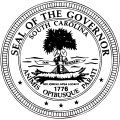Henry Middleton (governor)
Henry Middleton | |
|---|---|
| United States Minister to Russia | |
| In office June 17, 1821 – August 3, 1830 | |
| President | James Monroe John Quincy Adams Andrew Jackson |
| Preceded by | George Washington Campbell |
| Succeeded by | John Randolph (did not present credentials) |
| Member of the U.S. House of Representatives from South Carolina's 1st district | |
| In office March 4, 1815 – March 3, 1819 | |
| Preceded by | Langdon Cheves |
| Succeeded by | Charles Pinckney |
| 43rd Governor of South Carolina | |
| In office December 8, 1810 – December 10, 1812 | |
| Lieutenant | Eldred Simkins |
| Preceded by | John Drayton |
| Succeeded by | Joseph Alston |
| Member of the South Carolina State Senate from St. Phillip's and St. Michael's Parish | |
| In office November 26, 1810 – December 8, 1810 Alongside James Kennedy | |
| Preceded by | John Blake |
| Succeeded by | John Johnson |
| Member of the South Carolina House of Representatives from St. Phillip's and St. Michael's Parish | |
| In office November 22, 1802 – November 26, 1810 | |
| Personal details | |
| Born | September 28, 1770 London, England |
| Died | June 14, 1846 (aged 75) Charleston, South Carolina, U.S. |
| Political party | Democratic-Republican (until 1830) |
| Other political affiliations | Union Party of South Carolina (1830–onward) |
| Profession | planter, politician |
Henry Middleton (September 28, 1770 – June 14, 1846) was an American planter and political leader from Charleston, South Carolina. He was the 43rd Governor of South Carolina (1810–1812), and represented South Carolina in the U. S. Congress (1815–1819).
Life
[edit]Middleton served as Minister to Russia (1820–1830), being sent there in the first instance to replace George Washington Campbell, so as to look after interests in the discussions preparatory to arbitration by Czar Alexander I on the question of compensation under Article 1 of the Treaty of Ghent as regards enslaved Americans who went away with the British during and after the War of 1812.[1]
His summer home at Greenville from 1813 to 1820, known as Whitehall, was added to the National Register of Historic Places in 1969.[2] He and his family also spent some of their summer in Newport, RI staying at Stone Villa (demolished in 1957).
Family
[edit]His father (Arthur Middleton) and his grandfather (Henry Middleton) had both served in the Continental Congress. Williams Middleton was his son. He had 14 children with wife Mary Helen Hering, daughter of Julines Hering (1732–1797), a planter on Jamaica:[3] ten of their children lived into adulthood, including his youngest son Edward Middleton.
References
[edit]- ^ Harold E. Berquist, Jr (1981): Henry Middleton and the Arbitrament of the Anglo-American Slave Controversy by Tsar Alexander I, The South Carolina Historical Magazine Vol. 82, No. 1 (Jan. 1981), pp. 20-31
- ^ "National Register Information System". National Register of Historic Places. National Park Service. July 9, 2010.
- ^ "Summary of Individual Sir John Peniston Milbanke 7th Bart. 20th Aug 1775 – 1850, Legacies of British Slave-ownership". www.ucl.ac.uk.
External links
[edit]- United States Congress Biography of Henry Middleton
- SCIway Biography of Henry Middleton
- NGA Biography of Henry Middleton
External links
[edit]
- 1770 births
- 1846 deaths
- 19th-century American diplomats
- 19th-century American politicians
- 19th-century American planters
- Politicians from London
- Middleton family
- American people of Barbadian descent
- American people of English descent
- Democratic-Republican Party members of the United States House of Representatives from South Carolina
- Governors of South Carolina
- Democratic-Republican Party state governors of the United States
- Members of the South Carolina House of Representatives
- South Carolina state senators
- Ambassadors of the United States to the Russian Empire
- University of South Carolina trustees
- South Carolina politician stubs
